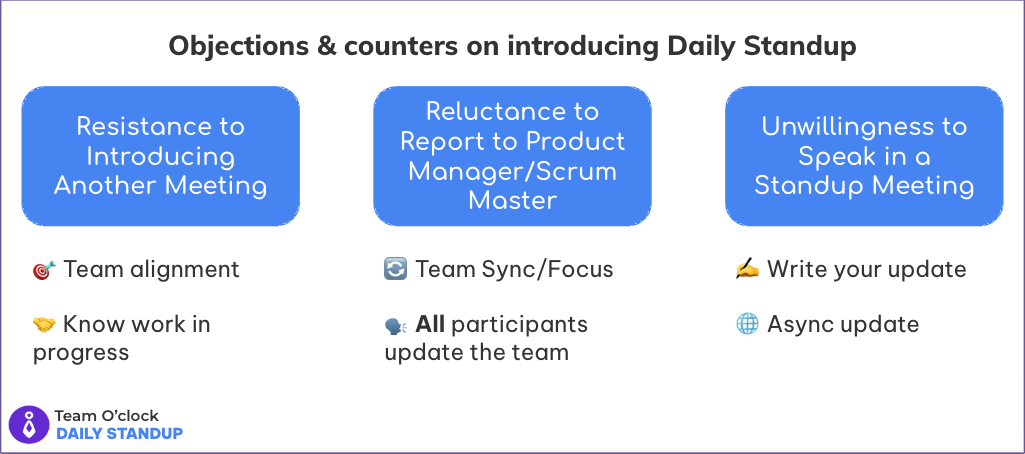
How to Introduce Daily Standup to Your Team as a Product Manager

Clear communication and efficient collaboration are critical skills in product management. The agile methodology, which has gained widespread popularity in recent years, strongly emphasizes these aspects. One of the essential tools in the agile arsenal is the daily standup meeting.
In this blog, we'll delve into the world of daily standup meetings, exploring their significance, the role of a product manager in facilitating them, and how to handle common objections from team members. We'll introduce you to our specialized solution to supercharge your standup meetings.
Why Are Daily Standup Meetings Important?
Before we dive into the nitty-gritty of introducing daily standup meetings to your team, let's first grasp why they are so crucial in the realm of agile project management.
Enhanced Communication, Collaboration, and Transparency
At its core, the daily standup meeting is all about fostering communication, collaboration, and transparency among team members. It's a brief, daily check-in where team members share updates on their work, discuss any impediments they're facing, and align their efforts toward a common goal.
Imagine a scenario where team members work on different aspects of a complex project. Without daily standup meetings, they might operate in silos, unaware of the progress or challenges their colleagues are encountering. This lack of visibility can lead to misalignment, duplication of efforts, and delayed problem-solving.
Daily standup meetings break down these barriers. They provide a dedicated time and space for team members to sync up, share their triumphs and tribulations, and rally around the project's objectives. This enhanced communication leads to better collaboration and, ultimately, more transparent project management.
Preparing for the Introduction
Now that we've established the significance of daily standup meetings let's discuss how you, as a product manager, can prepare for their introduction within your team.
Setting Clear Objectives and Expectations
Before conducting your first standup meeting, setting clear objectives and expectations is imperative. Define the purpose of the meeting: is it to track progress, identify and resolve issues, or both? Communicate these objectives to your team so they understand the "why" behind the daily standup.
Identifying the Right Team Members
Only some people on your team need to be part of the daily standup. Identify the key stakeholders and team members whose presence is essential. These individuals should be directly involved in the project and have valuable updates to share. Including too many people can lead to lengthy meetings that jeopardize their effectiveness.
How to Run Effective Standup Meetings
The following video provides a step-by-step guide on structuring a daily standup meeting.
https://www.youtube.com/watch?v=Shm7VLCaVgQ&ab_channel=ScrumAlliance
With the groundwork laid, let's move on to the nuts and bolts of running effective daily standup meetings.
Time Management
Time is of the essence in daily standup meetings. Keep them short and focused. Setting a time limit, such as 15 minutes, can help participants stay on track. Make sure to start and end the meetings punctually to respect everyone's time.
Engagement and Focus
To ensure that your standup meetings are productive, employ strategies to keep team members engaged and focused. Encourage everyone to share their updates succinctly and avoid delving into lengthy discussions. If an issue requires further discussion, it can be taken offline after the meeting.
3 Common Objections & How to Handle Them
Common objections can often arise during a daily standup meeting, ranging from concerns about project timelines and team hierarchy to unwillingness to participate actively. Here are three of the most common objections:
Objection #1: Resistance to Introducing Another Meeting
Solution #1: Standup meetings are primarily for team alignment and understanding the work in progress. They help everyone stay on the same page and are valuable to our workflow.
Objection #2: Reluctance to Report to Product Manager/Scrum Master
Solution #2: During the Standup, the focus is not on reporting to any specific individual like the Product Manager. Instead, it's about the entire team synchronizing and aligning their efforts. If a Product Manager joins, they should share updates that benefit the whole team, such as roadmap progress or key findings that impact the team's work.
Objection #3: Unwillingness to Speak in a Standup Meeting
Solution #3: While the standup is meant for alignment on ongoing work, you don't necessarily have to speak if you're uncomfortable. You can still contribute by sharing your progress asynchronously, for example, through text-based updates. This way, you can participate without the pressure of speaking in front of the team.

These objections are a natural part of the collaborative process, but product managers must address them promptly. Product managers ensure that the team maintains focus, alignment, and productivity. Timely resolution of objections prevents misunderstandings from festering and impacting progress.
It also fosters an environment of open communication and trust, allowing the team to adapt to changing circumstances more effectively. Ultimately, the product manager's handling of objections swiftly plays a pivotal role in maintaining a cohesive team and delivering successful outcomes.
Measuring the Impact and Continuous Improvement
Measuring the success of daily standup meetings is crucial for ensuring they remain effective in Agile teams. Here's a simple guide on how to do it:
Metrics for Success
Meeting Duration: Keep an eye on how long your standup meetings last. Shorter meetings often indicate better focus and efficiency.
Blocker Trends: Track the number of blockers raised and resolved daily. A decreasing trend in unresolved blockers is a good sign.
Team Engagement: Measure team engagement during meetings. Are team members actively participating and listening?
Feedback for Improvement
Regular Surveys: Collect feedback from team members regularly through quick surveys. Ask them about the meeting's effectiveness and what could be improved.
One-on-One Discussions: Don't hesitate to discuss one-on-one with team members to delve deeper into their thoughts and suggestions.
Open Forum: Encourage team members to share feedback openly during the meetings. This fosters a culture of continuous improvement.
The Importance of Adaptation
Continuous improvement is vital. Daily standup meetings are not set in stone and should evolve as the team's needs change. Here's why:
Adapt to Challenges: Agile is all about adapting to changes quickly. If something isn't working, be ready to tweak the meeting format or content.
Feedback Integration: Act on the feedback received promptly. Show your team that their input matters and that you're committed to improving the meetings.
Stay agile: Remember, Agile methodologies emphasize adaptability. Your daily standup meetings should mirror this principle by evolving to meet the team's changing needs.
In summary, measuring success with metrics and feedback and committing to continuous improvement ensures that your daily standup meetings remain valuable in your Agile toolbox, keeping your team on the path to success.
Team O'Clock: Your Standup Meeting Solution
As you embark on your journey to introduce daily standup meetings, consider leveraging specialized software solutions like Team O'Clock.
Team O'Clock is a dedicated software designed to enhance your Scrum meetings. It streamlines the process, making it easy for product managers and team leads to conduct efficient meetings. With features like automated agenda creation, progress tracking, and integrations with popular collaboration tools, Team O'Clock can save time and make your meetings more effective.
Don't just take our word for it – hear what other product managers and teams say about Team O'Clock.
Conclusion
In conclusion, daily standup meetings are a powerful tool for product managers looking to enhance communication, collaboration, and transparency within their teams. By understanding their importance, preparing for their introduction, and handling common objections, you can harness the full potential of these meetings. Remember to measure their impact and continuously improve the process.
If you're ready to take your daily standup meetings to the next level, consider exploring Team O'Clock. Its user-friendly features and proven success stories make it the perfect companion for product managers striving to make their teams more agile and efficient.
Embrace the power of daily standup meetings and watch your projects thrive.








